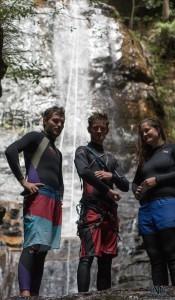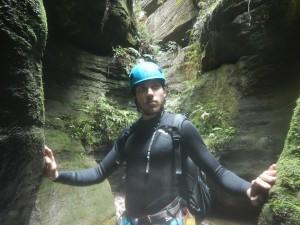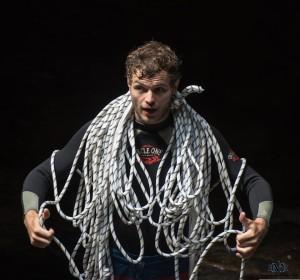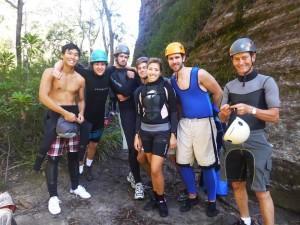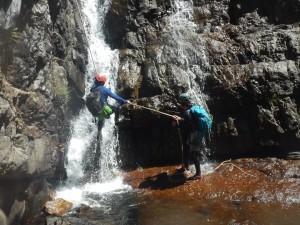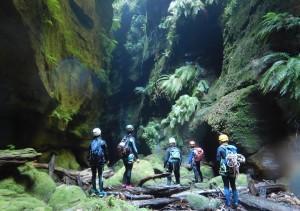These pages do not equip you with the skills to lead or go on a trip. The author and club accept no responsibility for the actions of those relying on the information herein. Outdoors activities are undertaken at an individual’s own risk. These pages contain general tips and advice. Use it as a guide to know what is advisable to have with you and what you should learn from appropriate courses and experienced leaders.
The canyoning trip leading tips on this page are designed to complement the main Trip Leading 101 page. Please see that page for general information on running any club trip.
Introduction
So, welcome current/aspiring Trip Leader. Want to go canyoning ay? Then read this I say! Canyoning is potentially the most dangerous beginner trip you can lead. If everything goes swimmingly it’s a very fun and straightforward day. This can lull unprepared individuals into going/leading canyoning, because if ANYTHING goes wrong and you are not totally prepared for it, things could go very very badly. Remember you are in one of the most inaccessible, cold and remote places in the mountains.
What you need to know to lead a canyoning trip includes (but is not limited to) the following:
What Skills Do I Need?
If you don't currently have all these skills, ask an experienced trip leader to teach you! Attend a club workshop, read widely or take a professionally taught course. However, to lead a canyoning trip you need to know how to:
- Safely set up abseils up to 60m, put people on abseil, make sure rope doesn’t catch on pull down
- Build abseiling anchors and assess the quality of existing anchors
- Use abseiling calls “abseiling, on belay, off rope”
- Top belay and fireman’s belay and know when it's better to use each
- Isolate strands (stone knot or alpine butterfly), biner block, tie two ropes together
- Ascend a rope. Transition from descending to ascending
- How to go down and rescue someone stuck on an abseil, or haul them up or lower them
- How to abseil off munter hitch and how to lock off a descender
- How to navigate if you lose the track, it gets dark, etc.
- Be a sexy beast like Dion
- And, you need to understand all of the hazards at the bottom of this page.
Before the Trip:
- Stick to the maximum group sizes for canyoning trips:
- 8 for vertical or Wilderness Canyons (like in the Wollemi).
- 12 for non-vertical canyons (no abseils).
- Make it clear that people need a good level of fitness and need to be able to swim (if a wet canyon).
- This page is good to link to for everyone canyoning, even if not leading, to help them understand the risks.
- Make sure every trip participant has before the trip:
- At least 2L water (If you all get stuck, you want enough to ration for another day. Plus on a long hot day I drink 3L, and people will undoubtedly not bring enough and borrow others. Know that you can generally drink canyon water but look into your specific canyon.
- Food: lunch, snacks.
- Emergency blanket (compulsory for all club canyons, can be bought from the gear cupboard for $5)
- Helmet*
- Wetsuit*
- Board shorts (to wear over wetsuit, compulsory if wearing a club wetsuit)
- Backpack (at least 25L, we may give you some group gear to carry)
- Dry bag*
- Enclosed Shoes (Volleys or old sneakers are good options)
- Woollen socks
- Headtorch
- Thermals to wear under wetsuit, or old rain jacket to wear over wetsuit if you get cold
- Dry thermals/jacket (not cotton!) for emergency
- Dry clothes to leave in car
- Sunscreen
- Small microfibre towel (optional, for drying yourself off before the walk out)
- Lilo (for lilo canyons)
- No cotton (it gets very cold when wet)
- ...And additionally for vertical canyons:
- Harness*
- Descender* (preferably figure 8 over ATC) and a carabiner
- Safety sling and carabiner*
- Prusik and carabiner* (unless all trip participants will be belayed)
- Items with an asterisk (*) can be borrowed from the gear cupboard.
- As a trip leader, you should be equipped with (in addition to the standard gear above):
- First aid kit (including snake bite bandages)
- PLB and know how to use one
- ~10m rope for hand-line in non vertical canyons. People may be a lot less comfortable with certain scrambles than you are.
- Always set up a handline if someone seems scared or unsure. Even if they say they don’t need it, it doesn’t hurt.
- Printed map and compass
- ...And for vertical canyons:
- Ropes (including enough spare such that if any one rope gets stuck, you can still safely complete the canyon)
- 5-10m tape and maillons for replacing anchors
- Extra prusik to allow ascending the rope if needed
- Rope protectors
- The club whistles and handheld radios can be useful on long abseils without line-of-sight
- Knife (may need to cut hair, rope, clothes, who knows)
- Spare headtorch and batteries
Before Leaving the Cars:
- When starting the canyon on the day it is good to give a briefing on a rough outline of the day, the potential hazards, the previous weather and forecast, to be careful near edges and moving over slippy rocks, to look out for themselves and others, to ask questions and to always follow your instructions. Oh and to have fun 😉
- Also in your briefing, if it's a vertical canyon, talk to them about how to abseil. i.e: abseiling calls, “thumb in bum” for more control, legs up and slightly apart, walk down, one hand can be used to fend wall. Also the fact they will be belayed (top or fireman's) so they are in safe hands. Talk them through all this again in the canyon when putting them on abseil.
- Check that harnesses and helmets are in safe working condition.
- Check that everyone is carrying an emergency blanket.
During the Trip:
- Keep an eye out for the hazards below, and deal with them appropriately.
Hazards
Some hazards of canyoning and some tips to deal with them.
Flash Flooding
- Slot canyons flash flood nearly every storm. They have caused many deaths in Blue Mountains Canyons and around the world. Do not take the risk of canyoning in rain.
- You must always check the forecast and note previous weather. If it has been raining in the prior hours/days, the catchment may be saturated and it takes even less rain to cause a flood.
- Any forecast of more than a couple mm would make it inadvisable to do a wet canyon. Definitely do not do any committing canyon. If there are any storms forecast you should not do any wet canyon and probably not a dry one either.
- When canyoning always note high points and escape points in a canyon to use if the water starts rising. There are reports of canyon water rising several meters in less than an hour (in storms that are not even that rare, occurring more than once a year)
- If caught in a flash flood try note how quick water is rising and if you can get to a known exit. Otherwise get to high points or spots out of the main flow.
Cold/Hypothermia
- Canyons are cold and dark with frigid water. This can sap people of heat.
- Make sure everyone has emergency dry clothes with them.
- Ask people to tell you when they’re getting cold as well as watch them yourself.
- If someone is getting cold, try to keep them moving, not wait so long for abseils, stand in the sun etc. Giving them a rain jacket can help insulate them and giving them snacks and sugar helps.
Abseiling
- Have safeties to clip to people. Don’t let them anywhere near the edge without it.
- Set people up on abseil correctly and double-check it. Have them weight the system before taking safety off.
- Talk them through the abseil techniques mentioned in the briefing above.
- Always fireman’s belay or top belay. Fireman’s belay is easier and quicker, but if the abseil is quite long, has dangerous ledges, or the belayer’s vision is impeded, then top belay is better.
- Be weary of edge wear on ropes. Use rope protectors.
- Read some great safety articles from UNSWOC trip leaders:
- Intro to Abseiling by Maria
- Edge Wear of Ropes by Brendan
- Safer Abseiling and Safer Abseiling Instruction by Sam
Drowning/Cramps
- If someone can't swim they shouldn't be in a canyon with swims. This would be in you trip description and morning check.
- People can cramp up or grow tired while swimming and sink. Especially on longer days and in the very cold water.
- Hence make sure everyone has a dry bag (to float) or swim near those who do not.
- Look out for less confident, cold or drybag-less swimmers when swimming.
Fall From Height, Slips, Trips and Falls
- Advise people to move slowly and carefully and be aware of and try stay away from drops and edges. If you are near a drop get low or even lie down so you can’t trip and fall off. Try let them know where there are dangerous drops and slippy areas
- Move slowly using hands and feet and getting down on your bum when safer.
- Sprained/broken ankles as well as lacerations are common. Have first aid kit (and know how to use it) and PLB.
Hitting Submerged Debris
- Never jump without checking the water for rocks and logs. Someone should climb or abseil down and swim underwater to check. Even if you did a canyon recently a storm could have washed in debris.
- Always point to safety (where is safe to jump to) not to where danger is. As people may not hear what you’re saying
- Even though someone’s checked the pool already and it should be safe, use hand signals after jumping:
- Hand swipe over top of your helmet without touching helmet – Didn’t touch ground/debris, safe to jump
- Tap top of helmet – touched but ok to jump, be wary, bend legs
- Frantic waving crossing hands (or you’re injured and clutching your legs) – Don’t jump! Someone did not check all of pool or wide/deep enough area. Should’ve abseiled/climbed down.
Snake Bite
- Make sure you have snakebite bandages and a registered PLB to set off. These can all borrowed from the club. Read St John’s first aid advice on what to do.
Waterfalls/Rough Water (in more advanced, definitely not beginner friendly canyons)
- Always try avoid being in rushing water/waterfalls as they are very powerful and can wash you away or freeze you to death.
- Always try set up abseils away from waterfalls. If forced to abseil through, instead of next to, a waterfall:
- Be very sure your ropes make it to the ground and aren't tangled.
- Know you can switch to ascent quickly, preferably with ascenders not tricky, slow, catchy prusiks.
- Keep your head down to breathe and try move fast.
-
Single rope technique (SRT) should be used.
-
Rig for rescue (i.e. the anchor should be rigged so that it is able to be released and the rope lowered if someone is stuck on rope. It may well be impossible to ascend if in any significant water flow).
And that's all for now. Well done! You made it to the end. I hope you've learned a lot. If you need to learn more or don't understand all parts of this document, ask more experienced leaders and/or do appropriate courses.
So do your best to be safe out there, learn as much as you can, accompany experienced leaders and of course, have fun 🙂




